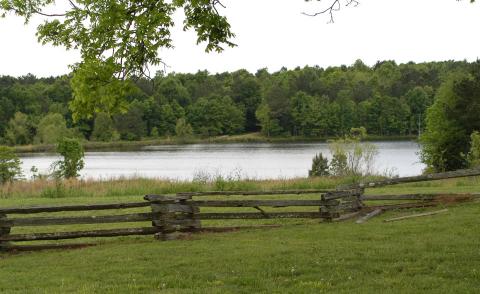Gerald Almy | Originally published in GameKeepers: Farming for Wildlife Magazine
Nothing can top food plots for improving the health of our deer herds. Food plots increase the number of animals you can support, improve the health of does and fawns, and dramatically enhance the size of the antlers bucks grow. They also help you establish movement patterns of your bucks from bedding to feeding areas, making hunting them easier.
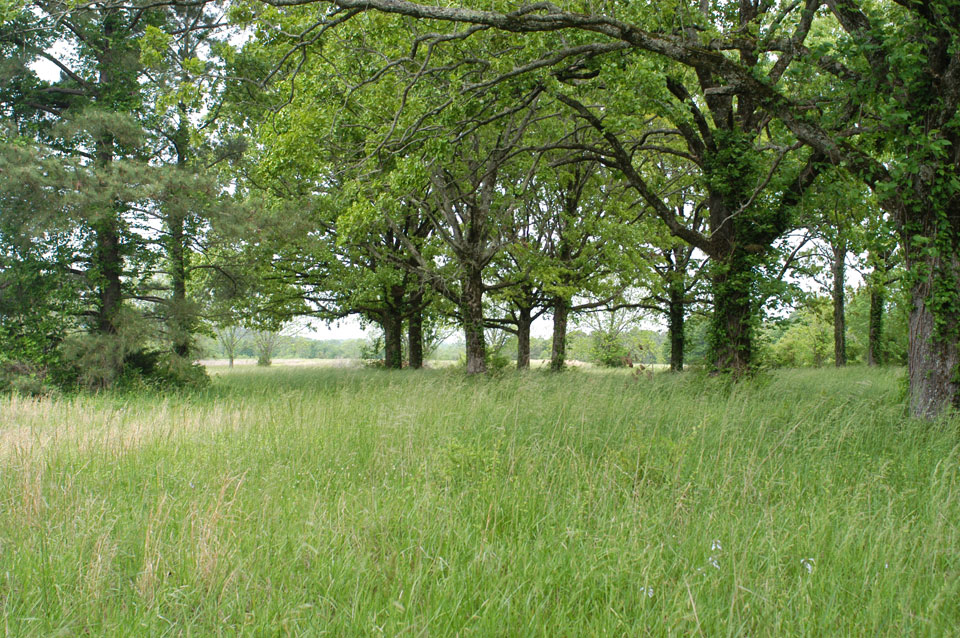
Establishing and maintaining food plots constitutes the majority of my habitat work as a gamekeeper, and it should yours, too. But there are lots of other things you can do to improve your property that will not only attract deer to your hunting land, but also hold them there and make it their full-time home.
If you fatten up a buck all summer but your neighbor has better cover, he may well head there as soon as the hunting pressure starts in the fall. Or the buck may be living there already and using your property as his “dining room,” using your plots mostly at night and returning to the neighbor’s property before daylight hunting hours. You definitely don’t want that to happen. One easy way to insure that it won’t is to establish stands of warm season grasses on your land.
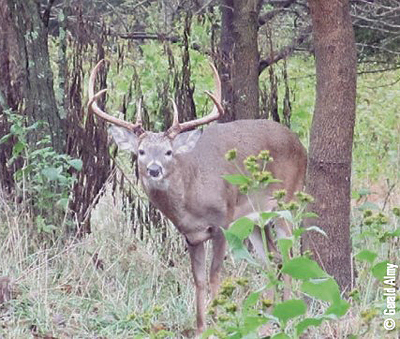
nearby and cover such as native warm season grass
stands. Native warm season grass stands provide a big
benefit for the work and cost involved.
Some of the best habitat work I’ve done on my 117 acres in northwestern Virginia has been establishing stands of these native warm season grasses. They grow six to eight feet tall, require little maintenance and are magnets for mature bucks seeking a sanctuary from hunting pressure.
When bucks pile into these areas searching for estrus does that may be escaping from hunting pressure, or simply to rest after feeding in my food plots, I leave them alone. I hunt only near the edges when they venture out to feed or chase the “ladies.”
Watching these areas, I’ve seen monsters that make my neighbors who lack warm season grasses, green with envy. A prime example would be the seven-year-old, four by five with six-inch bases that I shot near a switchgrass stand last fall.
You don’t need lots of land to benefit from warm season grasses. After all, my property is just over 100 acres. But with the right cover that’s enough acreage to make a buck stay put most of the time.
I’ve had bucks use fields as small as one-half acre. A two to 10 acre stand, though, is certainly better and larger areas better than that if you have a sizeable property.
Try to devote about the same amount of acreage to these as you do food plots. While food plots will attract deer and make them use your property, warm season grass stands will provide the cover you need to keep them there and make your land their home. Obviously you’ll need water somewhere nearby also, but the grass stands make exceptional living space.
Warm season grasses originally covered most of the country, basically anywhere forest didn’t grow. They dominated the land before European settlers arrived. Indians wisely used fire management to maintain healthy stands of the grasses.
When settlers from Europe brought in the plow, the decline of native warm season grasses began. The introduction of fescue was the last nail in the coffin for the grasses throughout most of the east. That’s unfortunate, because they are far superior for wildlife habitat when compared to the cool season grasses that carpet most pasture land today in the eastern half of the United States.
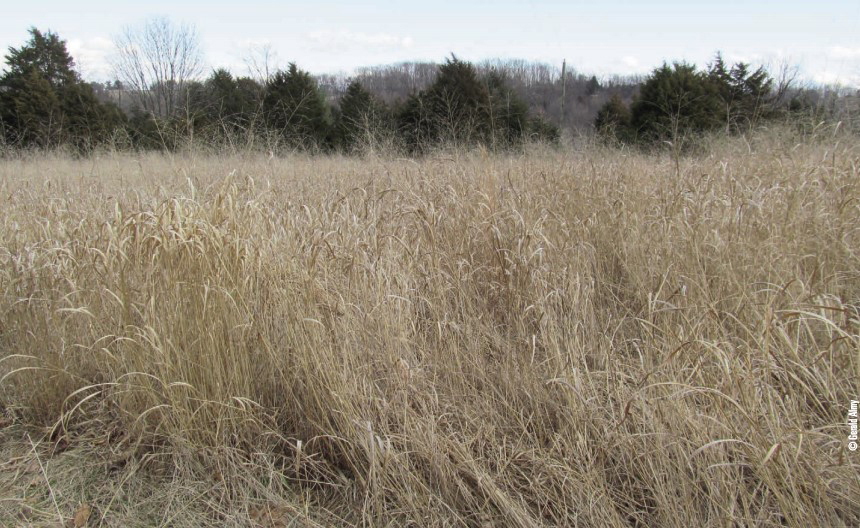
The Benefits of Native Warm Season Grasses
As the name implies, these grasses do most of their growing during the warm summer months. From April into June is the perfect time to plant them, depending on your location north to south. Late summer and early fall plantings will work as well, after all, that’s how established stands spread—by seeds falling off the mature grass in autumn and germinating from the moisture of fall rains or snow melt and spring rain-events the following year.
The grasses grow readily in a wide variety of soils. In most cases no fertilizer is required, and they can take an acidic pH as low as 5.2.
While their primary value is for cover, if it’s cut or burned, deer will eat the fresh shoots that crop up after as well as the abundant forbs that emerge between the clumps of stalks.
Warm season grasses can yield four to seven tons of hay per acre. Cuttings should be done after pheasant and quail nesting is finished in July. That way the grasses can regrow several feet tall again before fall, providing cover in spite of being hayed.
If possible, however, don’t cut the grasses at all. This is how you’ll get the most benefit from them. Let them grow to their full height of six to eight feet or more. That way they’ll provide maximum cover, that’s what they’re best at.
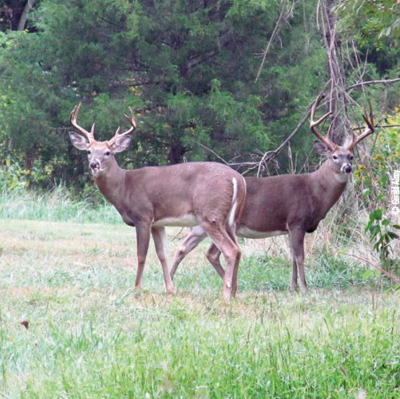
stand of native warm season grasses.
Warm season grasses grow thick, but in clusters so deer, turkeys, pheasants and quail can with no trouble walk between the clumps. Established stands tower high enough to easily conceal a mature buck. Another plus of warm season grasses is they are extremely drought resistant. Their roots can extend down to twelve feet deep. They can easily survive over a month without rain.
Planting a few strips or fields is the perfect way to draw deer to your land and keep them there when the pressure mounts on surrounding properties. These grasses are also great for planting around the perimeter of food plots or in narrow strips leading into the plot, so mature bucks feel comfortable using them during daylight.
Several species are useful: switchgrass, eastern gamma, Indian grass, and both, big and little bluestem. It’s often best to plant a mixture, in case some thrive better than others in your local soil and growing conditions.
Switchgrass is perhaps the easiest to plant and most reliable. It’s particularly good for wet areas and can survive flooding for well over 30 days. Indian grass is especially good for dry upland areas.
Planting Warm Season Grasses
Planting native warm season grass stands can be tricky. If at all possible, get a local expert to help or someone who has planted them before. Often government conservation agencies like the National Resources Conservation Service can help.
First you must choose a good location. Old crop fields are great or level areas that you can easily clear. I focus on areas that for some reason are not the very best spots to put food plots.
Remove rocks, sticks and debris. If the soil is very poor, such as in a forest log landing site, do a soil test and apply fertilizer as recommended to bring soil up to proper levels. If you want to boost production of a stand once it’s established, you can also apply a balanced fertilizer as well, but it’s not usually required.
Spray with glyphosate to kill any existing vegetation. Wait seven to ten days and spray again if there is any green still showing. Mow down the existing grass or vegetation if it’s more than a few inches tall.
At this point you have two options. One is to till the ground several times, cultipack it, and then broadcast the seed at about seven to ten pounds per acre depending on the seed chosen. Lightly drag or cultipack the seed so it’s only covered about a quarter inch. Seed may still show on the surface. Cultipack or drive over it with tractor tires again to firm the bed.
Option two is to locate a warm season grass drill. Many county or local conservation service agencies have these to rent or loan. Use the drill behind a tractor to plant directly into an herbicide-treated field without tilling. Set the drill for ¼ inch and use about seven to ten pounds of pure live seed per acre, again depending upon the seed species you have chosen. (Yet another option is to hire a local farmer experienced with native warm season grasses to plant the field for you.)
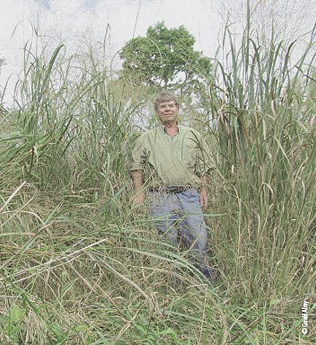
grow ten feet tall or higher and stand up well to
the elements.
While little or no fertilizer or lime is required in many cases, weed control is important, especially for the first year. Mow weeds down to about four inches high when they first start to shade the emerging grass. Later, mow down to about six to eight inches high. Then mow again later in the summer as needed at higher levels. Always be careful to cut higher than the desired grass. You never want to cut it the first year, just the weeds growing taller than the warm season grasses.
Maintaining Warm Season Grasses
Management is simple: 1) do nothing, 2) mow/hay them or 3) burn them. If you hay them, don’t cut lower than six to 10 inches and leave several areas or strips along field edges uncut for cover—you don’t want to remove all “housing.” A mowing rotation works well so there is always ample cover remaining.
If you choose to burn it should be done during the spring every second or third year. Forestry departments will help for a modest fee. Burning thickens and improves the health of warm season stands. It recycles nutrients that are tied up in the dead standing grass from previous years, helps control invasion from brush and weeds and removes old clumps that make it hard for quail to travel.
I’ve used it many times on my stands and the grasses always come back stronger, with new lush green growth appearing within days of the burn. (As a bonus, burning also makes it easy to find sheds in the field.)
You only need to burn once every two to four years. A good policy if you have enough warm season grass fields is to burn some one year and others a different year.
Burning is best done in spring when newly-emerged grasses are one to two inches tall. If you think you might burn your stands, having a perimeter strip of clover or orchard grass about 12 feet wide around the edges helps with the logistics of fire control.
Conclusion
It may take a year or two to have a good grass stand develop…be patient. When it does, you’ll have a spot that will draw big bucks like a magnet after they chow down in your food plots. And that one-two punch of food and cover is the key to the best whitetail properties and the best big-buck hunting.
Free advice and sometimes cost-sharing is available from agencies such as your local Natural Resources Conservation Service, Soil and Water Conservation District or Farm Service Agency.














